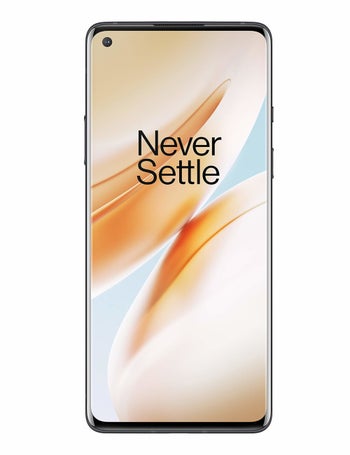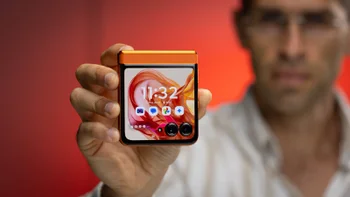OnePlus 8T vs OnePlus 8 Pro
We may earn a commission if you make a purchase from the links on this page.

Like clockwork, the second OnePlus flagship of the year, the OnePlus 8T is here and ready to kick some Android flagship butt! But as smartphones are evolving and getting closer and closer to perfection, it's getting hard to come up with two flagships that are different enough to justify their existence. So, did OnePlus pull it off? Well, that's what we're about to find out in this OnePlus 8T vs OnePlus 8 Pro comparison.
You might also want to check our OnePlus 8T vs Samsung Galaxy S20 FE comparison.


OnePlus 8T vs OnePlus 8 Pro: design comparison
They say everything new is a well-forgotten old but in the case of the OnePlus 8T, it's not really forgotten at all. We're talking, of course, about its flat display. The biggest difference between the 8T and the 8 Pro. With its previous generation, OnePlus made a bold decision to give both of its phones curved-edge displays in an attempt to make them look sleek and fancy. Which they did, but that's not something OnePlus fans are known to be looking for. They want performance and they want practicality.

The design of the OnePlus 8T can hardly be called unique
So, OnePlus obliged and now we once again have a high-end OnePlus phone with a flat display. It's worth noting that there's no OnePlus 8T Pro, which makes us think that the curved-edge display might be back with the OnePlus 9 and the Pro moniker could be retired. That would certainly be a good way for OnePlus to diversify the two models and keep fans of each display type happy.
Speaking of the display, it's a 6.5-inch one compared to the 6.8-inch one on the OnePlus 8 Pro. It has a Full HD+ resolution rather than Quad HD, which makes it more of a flat version of the OnePlus 8 display. The key difference, besides the shape, is that the one on the OnePlus 8T comes with a 120Hz refresh rate.
The other major change between the OnePlus 8T and the OnePlus 8 Pro is the shape and position of the camera module. It wasn't long ago when OnePlus was saying how the centered, vertical camera bump was a signature element for the brand. It seems it wasn't that important after all and the 8T sports rather generic-2020-looking cameras on the back. Perhaps the decision was forced by changes in the internal component layout of the phone but either way, this is the new look OnePlus is going for.
OnePlus 8T vs OnePlus 8 Pro: specs comparison
Usually, one key difference between the OnePlus T models and the non-T ones is that the former have the updated plus version of Qualcomm's latest 800-series chip if one is available. And this year there is a Snapdragon 865+ but the OnePlus 8T doesn't have it. It uses the same Snapdragon 865 as the OnePlus 8 and 8 Pro. So, what performance benefit are we getting for waiting 6 months more?
Well, let's take a quick look:
|
|
|
|
| OnePlus 8T | OnePlus 8 Pro | OnePlus 8 |
Hardware
| System chip | ||
|---|---|---|
| Snapdragon 865 SM8250-AB (7 nm) | Snapdragon 865 SM8250 (7 nm) | Snapdragon 865 SM8250 (7 nm) |
| Processor | ||
| Octa-core Kryo 585 | Octa-core Kryo 585 | Octa-core Kryo 585 |
| GPU | ||
| Adreno 650 | Adreno 650 | Adreno 650 |
| Memory | ||
| 12GB (LPDDR4)/256GB (UFS 3.1) 8GB/128GB |
8GB (LPDDR5)/128GB (UFS 3.0) 12GB/256GB | 8GB (LPDDR4)/128GB (UFS 3.0) 12GB/256GB |
| Storage expansion | ||
| not expandable | not expandable | not expandable |
| OS | ||
| Android (11) | Android (11, 10) | Android (11, 10) |
Battery
| Type | ||
|---|---|---|
| 4500 mAh | 4510 mAh, Li - Polymer | 4300 mAh, Li - Polymer |
| Charging | ||
| OnePlus Warp Charge | OnePlus Warp Charge Qi wireless charging, Reverse wireless charging |
OnePlus Warp Charge |
| Charge speed | ||
| Wired: 65.0W | Wired: 30.0W Wireless: 30.0W |
Wired: 30.0W |
See the full
OnePlus 8T vs OnePlus 8 Pro vs OnePlus 8 specs comparison
or compare them to other phones using our
Phone Comparison tool
As you can see, it's a mixed bag. You get more RAM with the 8T, but it's the slower type. You get more storage, but what's not visible here, but you can see in the full specs comparison, is that it's also the faster, UFS 3.1 type. And you get the bigger battery despite the 8T having a body similar to that of the OnePlus 8. Overall, the changes are in favor of the OnePlus 8T. Would we have also liked to see the Snapdragon 865+? Sure! But keep in mind that the 8T is also cheaper than the 8 Pro.
A significant difference is also the lack of wireless charging on the OnePlus 8T. How big of a deal that is, depends mostly on whether or not you have an established Qi-charging infrastructure where you live/work. Some say it's a must for flagship phones and we mostly agree but perhaps we'll get it back with the OnePlus 9. At least you have a super-fast 65W wired charging (with the charger in the box!), so you can't complain too much.
OnePlus 8T vs OnePlus 8 Pro: camera comparison

Before we get to the camera samples, let's take a look at what hardware the two phones have at their disposal. Here are the raw numbers:
|
|
|
|
| OnePlus 8T | OnePlus 8 Pro | OnePlus 8 |
Camera
| Rear | ||
|---|---|---|
| Quad camera | Quad camera | Triple camera |
| Main camera | ||
| 48 MP (OIS, PDAF) Aperture size: F1.7 Focal length: 26 mm Sensor size: 1/2" Pixel size: 0.8 μm | 48 MP (OIS, Laser and PDAF) Aperture size: F1.8 Focal length: 25 mm Sensor size: 1/1.4" Pixel size: 1.12 μm |
48 MP (OIS, PDAF) Aperture size: F1.8 Focal length: 25 mm Sensor size: 1/2" Pixel size: 0.8 μm |
| Second camera | ||
| 16 MP (Ultra-wide) Aperture size: F2.2 Focal Length: 14 mm Sensor size: 1/3.6" Pixel size: 1 μm |
48 MP (Ultra-wide, PDAF) Aperture size: F2.2 Focal Length: 14 mm Sensor size: 1/2" Pixel size: 0.8 μm |
16 MP (Ultra-wide, PDAF) Aperture size: F2.2 Focal Length: 14 mm |
| Third camera | ||
| 5 MP (Macro) Aperture size: F2.4 | 8 MP (Telephoto, OIS, Laser and PDAF) Optical zoom: 3.0x Aperture size: F2.4 Sensor size: 1/2" Pixel size: 1 μm |
2 MP (Macro) Aperture size: F2.4 Pixel size: 1.75 μm |
| Fourth camera | ||
| 2 MP (Black and White) Aperture size: F2.4 | 5 MP (Color filter) Aperture size: F2.4 | |
| Flash | ||
| Dual LED | Dual LED | Dual LED |
| Video recording | ||
| 4K UHD (60 fps), 1080p (240 fps), 720p (480 fps) Time-lapse video, EIS | 4K UHD (60 fps), 1080p (240 fps), 720p (480 fps) OIS, HDR, EIS | 4K UHD (60 fps), 1080p (240 fps), 720p (480 fps) OIS, HDR, Time-lapse video, EIS |
| Front | ||
| 16 MP (EIS, HDR) Video capture: 1080p | 16 MP (EIS, HDR) Video capture: 1080p | 16 MP (EIS, HDR) Video capture: 1080p |
See the full
OnePlus 8T vs OnePlus 8 Pro vs OnePlus 8 specs comparison
or compare them to other phones using our
Phone Comparison tool
As you can see, the OnePlus 8T is closer to the OnePlus 8 than to the 8 Pro when it comes to camera hardware. And although technically it has a quad-camera system, two of them, the Macro Lens and the Monochrome Lens, are more or less just to bump the total number up. At least the macro sensor is now a 5MP one, which will hopefully make it more useable than that of the OnePlus 8. We'd much rather have those "lesser" lenses replaced by a telephoto one but it seems OnePlus isn't eager to get involved in the zoom race some phone manufacturers have been participating in lately. The main sensor on all three phones is the same, no upgrade there.
Now let's look at some camera samples from the OnePlus 8T:
As we can see, the overall performance is quite good, even at night. What we've noticed however, is some inconsistency between the shots. Sometimes the colors are just right, well-balanced and pleasing to look at, while in other shots the colors are washed out and lack that pop that makes you go "Wow, that's a great photo!" That's what separates the really good cameras from the best cameras these days, the margins are so narrow. And, unfortunately, the OnePlus camera isn't quite on par with the best just yet.
And when it comes to comparing the 8T to the 8 Pro or the 8, you can expect very similar results and any improvements in the camera software that may come in the future will surely reach all three devices.
To wrap things up, here's a quick look at a couple of front-facing camera photos:
Different lighting conditions, but the colors on the OnePlus 8T photo are much nicer and it's overall a great selfie. Overall, it's safe to say that when choosing between these phones, the cameras shouldn't be a deciding factor. What, then? Well...
Conclusion
Let's be clear, there's zero reasons to buy the OnePlus 8T if you have any of the OnePlus 8 phones. Okay, maybe one, if you really, really have to have a flat display and you thought they were never coming back so you bought an OnePlus 8/8 Pro. That being said, we like the direction OnePlus is going with this new T model and we're hoping it will stick to this strategy in the future. A flashier, more expensive OnePlus flagship at the start of the year, and a more essentials-only model towards the end of the year sounds like a good plan. We're sure plenty of hardcore OnePlus fans are happy to see the OnePlus 8T and will finally pull the trigger on a new phone. And the rest, well, surely they can wait 6 more months before upgrading.
We'll update this review as soon as we have our full impressions of the OnePlus 8T, alongside its benchmarks and camera samples, so we can have the full data needed for the proper comparison between the OnePlus 8T and the OnePlus 8 Pro.
Follow us on Google News


















Things that are NOT allowed:
To help keep our community safe and free from spam, we apply temporary limits to newly created accounts: